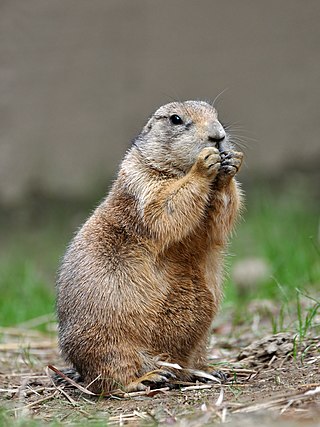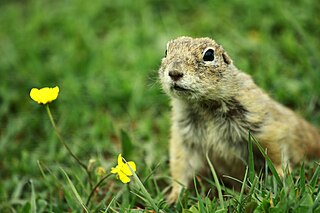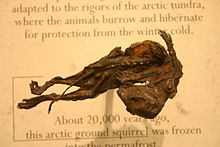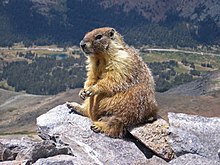
Chipmunks are small, striped rodents of Sciuridae, the squirrel family; specifically, they are ground squirrels (Marmotini). Chipmunks are found in North America, with the exception of the Siberian chipmunk which is found primarily in Asia.

Prairie dogs are herbivorous burrowing ground squirrels native to the grasslands of North America. There are five recognized species of prairie dog: black-tailed, white-tailed, Gunnison's, Utah, and Mexican prairie dogs. In Mexico, prairie dogs are found primarily in the northern states, which lie at the southern end of the Great Plains: northeastern Sonora, north and northeastern Chihuahua, northern Coahuila, northern Nuevo León, and northern Tamaulipas. In the United States, they range primarily to the west of the Mississippi River, though they have also been introduced in a few eastern locales. They are also found in the Canadian Prairies. Despite the name, they are not actually canines; prairie dogs, along with the marmots, chipmunks, and several other basal genera belong to the ground squirrels, part of the larger squirrel family (Sciuridae).

Squirrels are members of the family Sciuridae, a family that includes small or medium-sized rodents. The squirrel family includes tree squirrels, ground squirrels, and flying squirrels. Squirrels are indigenous to the Americas, Eurasia, and Africa, and were introduced by humans to Australia. The earliest known fossilized squirrels date from the Eocene epoch, and among other living rodent families, the squirrels are most closely related to the mountain beaver and to the dormice.

Marmots are large ground squirrels in the genus Marmota, with 15 species living in Asia, Europe, and North America. These herbivores are active during the summer, when they can often be found in groups, but are not seen during the winter, when they hibernate underground. They are the heaviest members of the squirrel family.

Franklin's ground squirrel is a species of squirrel native to North America, and the only member of the genus Poliocitellus. Due to the destruction of prairie, the populations of Franklin's ground squirrel have dwindled, approaching levels of concern. Its decline in the eastern portion of its range is mostly attributed to habitat fragmentation.

Spermophilus is a genus of ground squirrels in the squirrel family. As traditionally defined the genus was very species-rich, ranging through Europe, Asia and North America, but this arrangement was found to be paraphyletic to the certainly distinct prairie dogs, marmots, and antelope squirrels. As a consequence, all the former Spermophilus species of North America have been moved to other genera, leaving the European and Asian species as true Spermophilus.

Richardson's ground squirrel, also known as the dakrat or flickertail, is a North American ground squirrel in the genus Urocitellus. Like a number of other ground squirrels, they are sometimes called prairie dogs or gophers, though the latter name belongs more strictly to the pocket gophers of family Geomyidae, and the former to members of the genus Cynomys.

Tamias is a genus of chipmunks in the tribe Marmotini of the squirrel family. The genus includes a single living species, the eastern chipmunk. The genus name Tamias means "treasurer", "steward", or "housekeeper", which is a reference to the animals' role in plant dispersal through their habit of collecting and storing food for winter use.

The alpine marmot is a large ground-dwelling squirrel, from the genus of marmots. It is found in high numbers in mountainous areas of central and southern Europe, at heights between 800 and 3,200 m (2,600–10,500 ft) in the Alps, Carpathians, Tatras and Northern Apennines. In 1948 they were reintroduced with success in the Pyrenees, where the alpine marmot had disappeared at end of the Pleistocene epoch.

Xerini is a tribe of ground squirrels occurring in Africa and Asia. With the tribes Marmotini and Protoxerini, they form the subfamily Xerinae. There are five living genera—Xerus, the unstriped ground squirrel; Euxerus, the striped ground squirrel; Geosciurus, the Cape and mountain ground squirrels; Atlantoxerus, containing the living Barbary ground squirrel of North Africa and some extinct species; and Spermophilopsis, containing the long-clawed ground squirrel of Central Asia.

The Arctic ground squirrel is a species of ground squirrel native to the Arctic and Subarctic of North America and Asia. People in Alaska, particularly around the Aleutians, refer to them as "parka" squirrels, most likely because their pelt is good for the ruff on parkas and for clothing.

The thirteen-lined ground squirrel, also known as the striped gopher, leopard ground squirrel, and squinny, is a ground squirrel that is widely distributed over grasslands and prairies of North America.

The Columbian ground squirrel is a species of rodent common in certain regions of Canada and the northwestern United States. It is the second largest member of the genus Urocitellus, which is part of the tribe Marmotini, along with marmots, chipmunks, prairie dogs, and other holarctic ground squirrels. They are stout, with short dense fur, which is characteristically tawny across the bridge of the nose. Social encounters sometimes are initiated with kissing behavior and the most common activity above ground is standing at attention. Residing in mountainous terrain and high plains in northern latitudes, they hibernate for 8 to 9 months of the year in burrows, which may be used for many years. They are emaciated when emerging in the spring. The Columbian ground squirrel came to the attention of the scientific community through writings produced by Lewis and Clark, while 21st century molecular genetics has more finely illuminated its ties with other close relatives.

The Xerinae comprise a subfamily of squirrels, many of which are highly terrestrial. It includes the tribes Marmotini, Xerini, and Protoxerini.

Otospermophilus is a genus of ground squirrels in the family Sciuridae, containing three species from Mexico and the United States. Otospermophilus was formerly placed in the large ground squirrel genus Spermophilus, as a subgenus or species group. Since DNA sequencing of the cytochrome b gene has shown Spermophilus to be paraphyletic to the prairie dogs and marmots, it is now separated, along with six other genera.

Notocitellus is a genus of ground squirrels, containing two species from Mexico. These species are the tropical ground squirrel, and the ring-tailed ground squirrel (N. annulatus). Notocitellus was formerly placed in the large ground squirrel genus Spermophilus, as a subgenus or species group. Since DNA sequencing of the cytochrome b gene has shown Spermophilus to be paraphyletic to the marmots, antelope squirrels, and prairie dogs, it is now separated, along with six other genera. The exact relations of this genus are unclear, though a relation to the antelope squirrels is possible.

Pygmy ground squirrels are small ground squirrels in the genus Xerospermophilus, family Sciuridae, containing four species from Mexico and the United States. The members of this genus were formerly placed in the large ground squirrel genus Spermophilus. Since DNA sequencing of the cytochrome b gene showed that Spermophilus was paraphyletic to the prairie dogs and marmots, this group is now separated, along with six other genera. Within the genus, the Mohave ground squirrel and the round-tailed ground squirrel were thought to be close relatives, sometimes a subgenus Xerospermophilus, while the spotted ground squirrel and the Perote ground squirrel were formerly placed in the subgenus Ictidomys.

Urocitellus is a genus of ground squirrels. They were previously believed to belong to the much larger genus Spermophilus, but DNA sequencing of the cytochrome b gene showed that this group was paraphyletic to the prairie dogs and marmots, and could therefore no longer be retained as a single genus. As a result, Urocitellus is now considered as a genus in its own right.

The Rio Grande ground squirrel is a species of squirrel in the family Sciuridae. It is found in the south-western United States and in north-eastern Mexico.




















